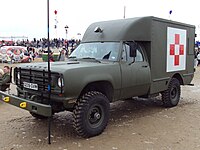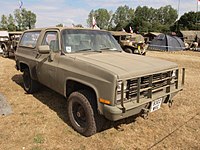Commercial Utility Cargo Vehicle

Unloading a LSSV Silverado & trailer, Yokota Air Base, Japan
The Commercial Utility Cargo Vehicle or CUCV/LSSV (CUCV /ˈkʌkviː/ KUK-vee)[1] is a vehicle program instituted to provide the United States military with light utility vehicles based on civilian trucks.
Contents
1 CUCV/COTS
2 Dodge M8XX Series
2.1 Powertrain
2.2 Variants
2.3 Operators
3 General Motors
3.1 CUCV
3.1.1 Powertrain
3.1.2 Axles
3.1.3 Electrical
3.1.4 Variants
3.2 Operators
3.3 CUCV II
3.3.1 Variants
3.4 Operators
3.5 LSSV
3.5.1 Variants
3.6 Operators
4 See also
5 References
6 External links
CUCV/COTS
The COTS (Commercial Off The Shelf)) concept, which translated into the CUCV program, was originally intended to augment the purpose-built but expensive Gama Goats and M151 series jeeps approaching the end of their service life in the mid-1970s.[2] Initially, Dodge W/D series trucks were provided in the late 1970s with several military modifications. In the mid-1980s, Chevrolet C/Ks replaced the Dodge vehicles in CUCV I and CUCV II guise. GM CUCVs were heavily redesigned in 2000 and their name was changed to Light Service Support Vehicle (LSSV).
CUCVs are intended to perform "background" roles, providing support for frontline forces, such as cargo transport, troop transport, first aid, and communications. CUCVs are not built for direct frontline combat use, as evident by their lack of bulletproofing and protection from ordnance. Like many of the vehicle parts, the windshield, cabin glass, and body panels are civilian-grade and offer no protection from firearms or explosives. As a result, some CUCVs were replaced in the 1980s and 1990s by the HMMWVs they were to augment.[3]
The U.S. military continued to keep CUCVs in active service long after their projected lifespan. CUCVs of all generations are still in U.S. service, though many M880/M890s and CUCVs have passed through military surplus sales into civilian ownership. CUCVs and LSSVs are in use as support vehicles for military police, troop transport, range control, facilities, and maintenance.
Dodge M8XX Series
| M880/M890 | |
|---|---|
 | |
| Overview | |
| Manufacturer | Dodge |
| Production | ~44,000 units |
| Model years | 1976–1977 |
| Body and chassis | |
| Body style | 2-door pickup |
| Powertrain | |
| Engine | Chrysler 318 cubic inch engine V8 |
| Transmission | Torqueflite 727 3-speed automatic |
| Dimensions | |
| Wheelbase | 131 in (3.3 m) |
| Length | varies by model |
| Width | 79.5 in (2.02 m) |
| Height | 73.85 in (1.876 m) |
| Curb weight | varies by model |
In 1973, Dodge began developing militarized adaptations of their current civilian trucks. In 1976, the M880/M890 series was put into production under a large contract.,[4] For almost a decade the Dodges were referred to as "880s", "890s", or most commonly called "five-quarters". The term "CUCV" did not appear until the 1980s when GM was contracted to replace the M880/90s.[2][4] The M8XXs were an attempt by the U.S. military to use commercial off-the-shelf (COTS) vehicles with minor modifications in non-combat roles.[4] They were intended to replace the M37, M715 and their related variants. The 1¼ ton M880-series was based on the Dodge W200, a ¾ ton capacity 4×4 civilian/commercial truck. The 880/90s had a 2500 lb cargo rating, enabling it to have a 5⁄4-ton load rating. The similar 1¼ ton M890-series was based on the Dodge D200, a ¾ ton capacity 4×2 civilian/commercial truck.[4] The M880/M890s had several failings: a gasoline powerplant, 12-volt electrical systems (a separate 24 volt system was added to communications units), and no power steering, due to the PS pump location being used for the 24V generator.[5] The 318 gasoline engine proved to be a fatal flaw as the military moved increasingly to diesel engines during this time period. The lack of power steering was a hindrance in off-road, close quarters, and snow-plowing duties (although most civilian and Air Force models had power steering). Around 44,000 M880/M890s were produced during the 1976–1977 model years and faithfully served the Army and Air Force until the late 1990s.[4]
An armored variant was built by Cadillac Gage as the Ranger.
Powertrain
All M880/M890s were powered by Chrysler's 5.2L 318 gasoline engine with a two-barrel Carter or Holley Carburetor. These were rated at 150 hp (110 kW) and 230 lb/ft of torque. Most were equipped with the Torqueflite 727 3-speed automatic,a precious few left the factory with a 4-speed manual. The 880s used a 2-speed NP203 transfer case. A Dana 44 4.10:1 front axle and floating Dana 60 4:10.1 rear axle completed the setup. They were equipped with front wheel disc brakes and rear wheel drums. 880/890s had a Military rated top speed of 70 mph (110 km/h).[4]
Variants
- M880: Standard 4×4 pickup[5]
- M881: M880 fitted with additional 100-amp 24-volt generator[5]
- M882: M881 fitted with additional 60-amp 24-volt generator and communications equipment[5]
- M883: M881 fitted with slide-in shelter kit[5]
- M884: M880 fitted with 100-amp 24-volt generator and slide-in shelter kit with tie-downs[5]
- M885: M880 fitted with slide-in shelter kit with tie-downs[5]
- M886: M880 ambulance[5]
- M887: M880 maintenance[5]
- M888: M880 telephone maintenance[5]
- M890: Standard 4×2 pickup[5]
- M891: M890 fitted with additional 60-amp 24-volt generator[5]
- M892: M890 fitted with additional 60-amp 24-volt generator and communications kit[5]
- M893: M890 ambulance version[5]
Operators
 Canada[5]
Canada[5]
 Lebanon [6]
Lebanon [6]
 United States of America[4]
United States of America[4]
1976 [4] M886

M880 variant with non-military modifications
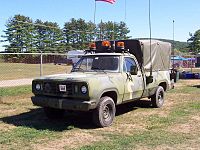
M882

1977 M886s
General Motors
General Motors and AM General have produced CUCVs since 1984 in three distinct generations: CUCV, CUCV II, and LSSV.
CUCV
| CUCV | |
|---|---|
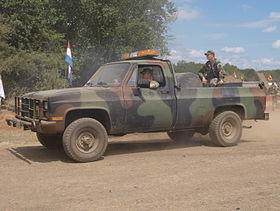 | |
| Overview | |
| Manufacturer | General Motors Defense |
| Model years | 1984–1987 |
| Body and chassis | |
| Body style | 2-door SUV 4-door SUV 2-door pickup 4-door pickup |
| Powertrain | |
| Engine | 6.2 L Detroit Diesel V8 |
| Transmission | 3-speed TH-400 automatic |
| Dimensions | |
| Wheelbase | 131.5 in (3.34 m) |
| Length | varies by model |
| Width | 81.2 in (2.06 m) wider for dual rear wheel models |
| Height | 75.4 in (1.92 m) |
| Curb weight | varies by model |
Replacing the M880/M890 series, the CUCV represented General Motors' first major light-truck military vehicle production since World War II.[7] GM CUCVs were assembled mostly from existing heavy duty light commercial truck parts. The CUCVs came in four basic body styles: pickup, utility, ambulance body and chassis cab.[7] The M1008 was the basic cargo truck, the M1010 was the ambulance, and the M1009 was a Chevrolet K5 Blazer uprated to ¾-ton capacity.[7] With the exception of the M1009, the trucks were all rated as 11⁄4 ton (commonly called a "five-quarter"), even though some of them had payloads in excess of that. There were heavier-duty variants, including the M1028, M1028A1, M1028A2 and M1028A3 shelter carriers (the shelter being a mobile command, communications or intelligence operations enclosure).[7] The M1031 was the chassis cab. These latter trucks were all rated for heavier 3,600 lb (1,600 kg) or 3,900 lb (1,800 kg) loads, compared to the M1008s 2,900 lb (1,300 kg) load capacity. The M1028A2 (converted M1031 or m1028a1) and m1028A3 (converted M1028) models had dual rear wheels. Many M1028s were upgraded at the company level to M1028A2 and A3 specs—the dual wheel rear end arrangement was a result of the M1028 flipping on its side because of the high center of gravity when carrying equipment shelters.[8]
GM produced some 70,000 CUCVs from 1983 to 1986 (model years were 1984–1987), though most were model year 1984.[7] Chevrolet continued to build CUCVs in low numbers from 1986 to 1996, mainly to accommodate military markets that needed replacements for existing CUCVs.
Powertrain
All CUCV Is were powered by GM’s 6.2L J-series Detroit Diesel V8 engine non-emissions diesel.[7] These were rated at 155 hp (116 kW) and 240 lb⋅ft (325 N⋅m), which was 5 hp (3.7 kW) more than the emissions diesel engine of the time. They were all equipped with the TH-400 automatic. All but the M1028A1 and M1031 used the NP-208 chain drive transfer case. The M1028A1 and M1031 units had a slip-yoke rear output version of the NP-205, which was specified mainly for its PTO capacity. The CUCV series had a governed top speed of 55 mph (89 km/h).
Axles
The M1009 Blazer used 10-bolt axles (front and rear) featuring 3.08:1 gears. The rear axle was equipped with an Eaton Automatic Differential Lock (ADL) while the front was a standard open differential. The M1008 trucks used open Dana 60 front axles, with the M1028 and M1031 variations often having a Trac-Lok limited slip. In the rear, the M1008s used the GM 10.5-inch (270 mm) 10.5" Corporate 14 Bolt Differential with No-Spin lockers (the commercial trade name for the Detroit Locker). Rear axles on M1028A2 and A3 duallies are Dana 70 HD. The axle gear ratios were 4.56:1.[9]
Electrical

Close-up of the NATO slave receptacle on an M1009
As with other military vehicles, the CUCVs used a 24-volt electrical system. It was actually a hybrid 12/24-volt system that used 24-volts under the hood, 24 volt starter, complete with dual 100 amp alternators, the mandatory NATO slave receptacle for jump starting any NATO vehicle, and hookups for military radios.[7] The rest of the truck was 12-volt.
Variants
- M1008: Basic General Motors Model K30903 except an NP208 transfer case where as the civilian model came with the NP205. The M1008 was the most numerous of the CUCV truck types. It was often seen with troop seats for eight in the bed. Fitments included a brush bar, front and rear tow hooks, and a pintle hitch. These trucks are rated to tow 3,000 lb (1,400 kg) and were often used to tow the M101 ¾-ton trailer.[7]
- M1008A1: M1008 fitted with additional 100-amp 24-volt generator and communications kit.[7]
- M1009: Utility version of the Chevrolet K5 Blazer. The M1009 is a utility rig built from a Blazer and could be used for command and control, as well as officer transport. Often seen with radio sets installed, however the large square tube stock mounts prevented the rear seat from being lowered. The M1009 was rated for a 1,200 lb (540 kg) payload and a 3,000 lb (1,400 kg) towed load. It used the heaviest duty GM springs available for the chassis and the rear axle was a 10-bolt unit. It rolled on 10.00-15 tires, had 3.08 gears and a rear Eaton automatic differential lock.[3]
- M1010: Ambulance version of the M1008.[7]
- M1010 [USMC Command]: USMC command post vehicle.[7]
- M1010 [USMC Ordnance]: USMC ordnance repair truck.[7]
- M1028: Shelter carrier version of the M1008.[7]
- M1028A1: Shelter Carrier w/ PTO version of the M1008.[7]
- M1028A2: Dual rear wheel w/ PTO version of M1028A1.[7]
- M1028A3: Dual rear wheel w/ NP208 version of M1028A2.[7]
- M1028FF: Fire fighting version of the GM1008.[7]
- M1031: Chassis-cab model[7]
Operators
 Albania
Albania
 Argentina [10]
Argentina [10]
 Canada
Canada
 Greece
Greece
 Estonia
Estonia
 Latvia
Latvia
 Lebanon [6]
Lebanon [6]
 Lithuania
Lithuania
 United States of America
United States of America
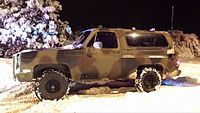
1984 M1009 CUCV in the snow

M1009
M1008A1
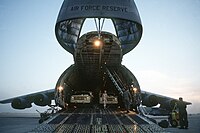
CUCVs loaded in a C-5A reserve aircraft, c. 1990

USAF M1008 being loaded into a Belgian Air Force C-130, 1998
M1009
CUCV II
| CUCV II | |
|---|---|
| Overview | |
| Manufacturer | General Motors |
| Model years | 1987–2000 |
| Body and chassis | |
| Body style | 4-door SUV 2-door pickup 4-door pickup |
| Platform | GM GMT400 platform |
| Powertrain | |
| Engine | 350 in³ (5.7 L) L05 V8 454 in³ (7.4 L) L29/L21 V8 6.5 L Detroit Diesel V8 |
| Transmission | 4-speed 700-R4 (4L60) automatic 5-speed manual |
| Dimensions | |
| Wheelbase | varies by model |
| Length | varies by model |
| Width | 81.2 in (2.06 m) |
| Height | 75.4 in (1.92 m) |
| Curb weight | varies by model |
In 1987, Chevrolet started building a new generation of CUCV. The US Air Force initially bought small batches of these units, dubbed the CUCV II.[11] Produced through 2001, CUCV IIs were basic civilian Chevrolet C/K, Tahoe, and Suburban units sent to another plant for "militarization" on special order. The trucks were originally white in color with gray vinyl interiors.[11] They received CARC exterior paint (Forest Green, Desert Sand, or 3-color camouflage), a brush bar, a pintle hitch, towing/loading shackles, extra leaf springs to give them a 5/4 ton rating and a host of other small changes. All CUCV IIs have a 24 volt dual-battery starting system, the rest of the truck is 12 volt.[11]
These light utility vehicles were available with three engines: a Vortec 7.4-liter V8, a 5.7-liter V8, or Detroit Diesel 6.5 L V8. Each engine was coupled with a 4-speed automatic or 5-speed manual transmission. All CUCV IIs have full-time all-wheel drive; a front-mounted winch was available as an option.[11]
Variants
- Type A: Two-door utility vehicle, with space for a driver and four passengers. Based on the K5 Blazer/Tahoe [11]
- Type B: Cargo truck, with open utility bed; seats could be fitted for troop transportation. Based on the Silverado[11]
- Type C: Ambulance, accommodating 4 stretchers or 8 seated casualties[11]
- Type E: Shelter carrier[11]
- Type F: Communications shelter carrier[11]
- Type S: Four-door command car, with space for a driver and five passengers. Based on the Suburban[11]
Operators
 Ecuador[11]
Ecuador[11]
 Saudi Arabia[11]
Saudi Arabia[11]
 Sweden[11]
Sweden[11]
 United Kingdom[11]
United Kingdom[11]
 United States of America[11]
United States of America[11]
 Venezuela[11]
Venezuela[11]
LSSV
| LSSV | |
|---|---|
 | |
| Overview | |
| Manufacturer | General Motors (Initial Production) AM General (Current Production) |
| Model years | 2001–present |
| Body and chassis | |
| Body style | 2-door SUV 4-door SUV 2-door pickup 4-door pickup |
| Platform | GM GMT880 platform |
| Powertrain | |
| Engine | 6.6 L Duramax V8 |
| Transmission | 4-speed 4L80-E automatic 5-speed Allison 1000 automatic |

LSSV Tahoes in Romania
When production of the CUCV II ended in 2000, GM redesigned it to coincide with civilian truck offerings. The CUCV nomenclature was changed to Light Service Support Vehicle in 2001. In 2005, LSSV production switched to AM General, a unit of MacAndrews and Forbes Holdings. The LSSV is a GM-built Chevrolet Silverado 1500, Chevrolet Silverado 2500 HD, Chevrolet Tahoe, or Chevrolet Suburban that is powered by a Duramax 6.6 liter turbo diesel engine. As GM has periodically redesigned its civilian trucks and SUVs from 2001 to the present, LSSVs have also been updated cosmetically.[12]
The militarization of standard GM trucks/SUVs to become LSSVs includes exterior changes such as CARC paint (Forest Green, Desert Sand, or 3-color Camouflage), blackout lights, military bumpers, a brush guard, a NATO slave receptacle/NATO trailer receptacle, a pintle hook, tow shackles and a 24/12 volt electrical system. The dashboard has additional controls and dataplates. The truck also can be equipped with weapon supports in the cab, cargo tie down hooks, folding troop seats, pioneer tools, winches, and other military accessories.[12] In the Canadian Army these vehicles are nicknamed "Milverado".
The Enhanced Mobility Package (EMP) option adds an uprated suspension, 4-wheel anti-lock brakes, a locking rear differential, beadlock tires, a tire pressure monitoring system and other upgrades. About 2,000 LSSV units have been sold to U.S. and international military and law enforcement organizations.[12]
Variants
- Cargo/Troop Carrier Pickup (2-door, Extended Cab, or 4-door Silverado)[12]
- Cargo/Troop Carrier/Command Vehicle (4-door Tahoe)[12]
- Cargo/Troop Carrier/Command Vehicle/Ambulance (4-door Suburban)[12]
Operators
 Canada[12]
Canada[12]
 Greece
Greece
 Romania
Romania
 United States of America[12]
United States of America[12]
See also
Hummer/HMMWV
- Land Rover Wolf
- Mercedes-Benz G-Class
Peugeot P4, the French version of the Mercedes-Benz G-Wagen- List of "M" series military vehicles
- Jeep
- M151
References
^ http://olive-drab.com/od_mvg_cucv_dodge.php
^ ab "About the CUCV". Olive-Drab. Retrieved 20 April 2014..mw-parser-output cite.citation{font-style:inherit}.mw-parser-output q{quotes:"""""""'""'"}.mw-parser-output code.cs1-code{color:inherit;background:inherit;border:inherit;padding:inherit}.mw-parser-output .cs1-lock-free a{background:url("//upload.wikimedia.org/wikipedia/commons/thumb/6/65/Lock-green.svg/9px-Lock-green.svg.png")no-repeat;background-position:right .1em center}.mw-parser-output .cs1-lock-limited a,.mw-parser-output .cs1-lock-registration a{background:url("//upload.wikimedia.org/wikipedia/commons/thumb/d/d6/Lock-gray-alt-2.svg/9px-Lock-gray-alt-2.svg.png")no-repeat;background-position:right .1em center}.mw-parser-output .cs1-lock-subscription a{background:url("//upload.wikimedia.org/wikipedia/commons/thumb/a/aa/Lock-red-alt-2.svg/9px-Lock-red-alt-2.svg.png")no-repeat;background-position:right .1em center}.mw-parser-output .cs1-subscription,.mw-parser-output .cs1-registration{color:#555}.mw-parser-output .cs1-subscription span,.mw-parser-output .cs1-registration span{border-bottom:1px dotted;cursor:help}.mw-parser-output .cs1-hidden-error{display:none;font-size:100%}.mw-parser-output .cs1-visible-error{font-size:100%}.mw-parser-output .cs1-subscription,.mw-parser-output .cs1-registration,.mw-parser-output .cs1-format{font-size:95%}.mw-parser-output .cs1-kern-left,.mw-parser-output .cs1-kern-wl-left{padding-left:0.2em}.mw-parser-output .cs1-kern-right,.mw-parser-output .cs1-kern-wl-right{padding-right:0.2em}
^ ab Mark, Alexander. "The M1009 CUCV - A Manly, Eco-Conscious, Military Rejected Survivalist," Dream Vehicle". Retrieved 20 April 2014.
^ abcdefgh "Dodge CUCV M880". Olive-Drab. Retrieved 20 April 2014.
^ abcdefghijklmno Turchet, Steve. "M880: A Tactical MV (sort of)". Military Trader. Retrieved 20 April 2014.
^ ab "Lebanese Armed Forces Vehicles: The CUCV (Dodge & Chevrolet)". Military In the Middle East. Retrieved 20 April 2014.
^ abcdefghijklmnopqr "Chevy CUCV M1008 M1009 M10xx Trucks". Olive-Drab. Retrieved 20 April 2014.
^ "Commercial Cargo Utility Vehicle". Warrior Lodge. Retrieved 20 April 2014.
^ "CUCV Technical Info". Motor Mayhem. Retrieved 20 April 2014.
^ http://k15.kn3.net/5A78EB1B0.jpg
^ abcdefghijklmnop "CUCV II Light Utility Vehicle". Military Today. Retrieved 20 April 2014.
^ abcdefgh "Light Service Support Vehicle (LSSV)". Olive-Drab. Retrieved 16 April 2014.
External links
| Wikimedia Commons has media related to CUCV. |
- GM CUCV Technical Info/Specifications
- GM Defense site
- M880 enthusiasts site
